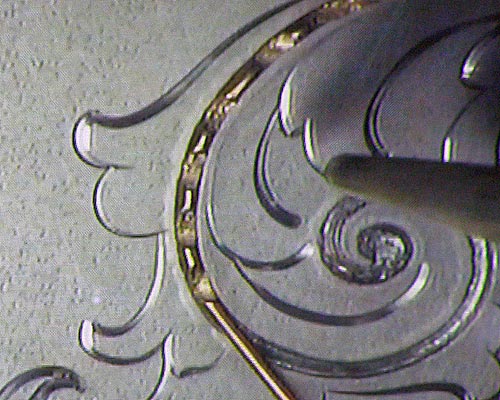It happens to all of us. Things seem to be going just fine with wire inlay, and suddenly you realize that the wire you're inlaying is too thin to fill part the channel you've cut. Perhaps you cut the channel too deep in one area, or maybe the undercuts are deeper in that spot. Every engraver should have several sizes of wire available when this situation arrises, but here's a trick that might save some time if your gold is slightly undersized.
When inlaying wire, the wire stretches lengthwise as it's hammered in. If you spot-set the wire in a few places first, this holds it in place and minimizes stretching as you drive down the remaining high spots, causing the gold to fill the undersized channel. There are limits, however. You can't expect thin wire to fill a wide channel, but this can save you from having to switch to different diameter wires in the middle of an inlay job.

Photos taken of classroom monitor during inlay demonstration.
GRS Intermediate Engraving Class
10/2006.

If you're new to gold wire inlay, don't try to save money by using lower karat golds. 24k gold is the most malleable metal in the world, and is very cooperative during the inlay process. 14k, 18k, 22k, require much more effort and are very difficult to drive into undercuts. My advice is to use nothing less than pure 24k gold.
You can purchase 24k gold from Stuller or Hoover & Strong. Phone them and order any dollar amount of 24k gold sheet or wire, and they'll tell you how much you will get based on spot price. For wire, I purchase 18 gauge and then draw it to different sizes in my studio. A drawplate with carbide inserts is a must, and available from all jewelers suppliers including Rio Grande.
|
|





